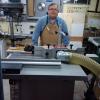Ok....so I managed to do something I never thought I would do, stop the blade on my 5hp PM2000. I was cutting 5ft long 1/2" BB with a Forrest Duraline HI-A/T Thin Kerf (bought when I had a contractor TS with only 1.75hp). What caused the binding was a full kerf riving knife. I removed the riving knife and the sheet good went through like butter. Lesson learned.
Now, I have just two questions:
- Did I just damage something with my TS by making the blade bind and stop?
- Is it safe to run full length sheet goods through the TS without a riving knife? I don't think it is, because kickback could still occur. However, to mitigate kickback without a riving knife, I'm also using Jessem's TS stock guides which have an anti-kickback feature to them, which I'm thinking mitigates the lack of a riving knife for something like sheet goods cut lengthwise through an entire panel.




 Reply With Quote
Reply With Quote





 )
)